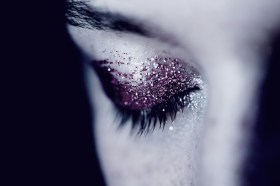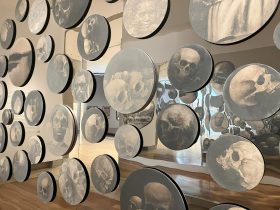In Māreikura–Ka rere te rongoā | the medicine flows, Irihipeti Waretini crafts an exhibition that invites the viewer into a space of sacred feminine spirituality. In many Indigenous traditions, women are revered and their vital contributions to the community are held in the highest esteem.
Māori culture is no exception; the role of women, especially as matriarchs known as kuia, is foundational in transmitting cultural values, oral traditions and spiritual practices.
Waretini is a Naarm-based visual and vocal storyteller, and cultural development and wellbeing practitioner.
The exhibition is presented as part of the Melbourne Museum’s initiative, Culture Makers. The program supports creatives to develop artistic experiences that engage audiences.
Māreikura–Ka rere te rongoā | the medicine flows combines a variety of elements to form a cohesive narrative akin to a healing sanctuary surrounded by the bustling activities of the Immigration Museum in the heart of Melbourne city. The creative output spans portraiture, soundscape and film.
The intimate display opens with a tall sculptural piece, Pou Atakau: Guardian Between Worlds. What stands as a potential confrontation evokes a sense of curiosity and welcome in equal measure. The work emphasises the importance of restoring the balance that has been systematically dismantled under the colonial hand. Under this system, “Māori women’s traditional power was undermined” (Te Ara).
The carved pillar rises dramatically on a raised platform, illuminated from below by small green and orange spotlights. This lighting creates a dynamic interplay of shadows and highlights that draws the viewer in for a closer inspection. Each intricate carving reveals a unique story, captivating the observer’s attention.
Pou Atakau: Guardian Between Worlds comprises an intentional composition that depicts the top: Tāwhirimātea (The Atua/god of Wind), centre: Papatūānuku (Mother Earth) and bottom: Tāne (The Atua/god of the Forest). In Māori cosmology, deities such as the aforementioned were originally viewed as equals, embodying a holistic worldview. Through this work, the artist questions the colonial impact through a narrative that often gendered these figures, reinforcing patriarchal hierarchies that undermine women’s significance in cultural practices.
The low-lit gallery houses 17 portraits, including the artist’s self portrait depicted as the religious figure of Mother Mary and her older brother, Eneti Te Kooro depicted as Rehua. In Māori mythology, Rehua is a prominent star associated with the god of healing and the embodiment of the spirit of the ancestors. In the portraits, the figures wear blindfolds symbolising their existence of “both being blindly led, and ancestrally guided”, according to the artist.
The portrait series also profiles Māori women. All sitters except two (the artist’s brother and an elder) proudly wear moko kauae (chin tattoos). Moko kauae among Māori women is a powerful symbol of identity, status, spirituality and cultural heritage.
Within the ever-changing contemporary society, tā moko (permanent marking/tattoo) practice emerges as a striking mark of cultural revival and resilience the practice of which was thwarted by colonisation. Through intricate designs, each marking resembles a visual language that tells the tales of the wearer’s life, values and experiences. Every line and curve has significance, making the body a canvas of personal and collective history.
The gentle meditative audio that fills the room beckons quiet moments of reflection for gallery visitors. Although the words are sung in language, the soundwaves that carry the essence of the message need no translation.
The third element of the installation comprises moving images fashioned from words. Words hold immense power; their communication transcends mere beauty. They serve as medicine, and when spoken with intention to oneself and others, they evoke the remembrance of one’s true self. Waretini weaves an ancestral memory with words, restoring dignity and connection while fostering ongoing wisdom.
Read: Circus review: La Clique, Sydney Opera House
Māreikura–Ka rere te rongoā | the medicine flows is a powerful exhibition that succeeds as an invitation to experience profound healing through shared stories, encouraging viewers to gain a fresh perspective on the world around them. While the impacts of colonisation are evident in our society, the process of rebuilding what has been lost is less visible.
As the viewer leaves the space, they are inspired to carry forward the lessons drawn from the exhibition, fostering a deeper appreciation for our shared humanity and encouraging a future rooted in respect and reconciliation.
Māreikura–Ka rere te rongoā | the medicine flows will be on display until 23 February 2025 at Immigration Musuem.





